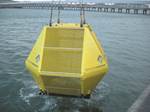New-Generation Composite Buoyancy Elements Key For Deep Drilling And Production
Principal suppliers of riser buoyancy products include major producer Balmoral (Aberdeen, Scotland, U.K. and Houston, Texas, U.S.A.) and CRP Group Ltd. (Skelmersdale, Lancashire, England, U.K.), which also owns Emerson & Cuming (Canton, Mass., U.S.A.). Balmoral customizes epoxy resins, which are used to cr
Principal suppliers of riser buoyancy products include major producer Balmoral (Aberdeen, Scotland, U.K. and Houston, Texas, U.S.A.) and CRP Group Ltd. (Skelmersdale, Lancashire, England, U.K.), which also owns Emerson & Cuming (Canton, Mass., U.S.A.). Balmoral customizes epoxy resins, which are used to create epoxy-based syntactic foams for a range of products matched to specific water depths and conditions. These circumstances vary so greatly that product development is very much project-driven. Buoyancy can be tailored for the needs of the installation by varying foam density, while still maintaining a high degree of performance and impact damage resistance in the modules.
In Balmoral’s UltraFloat range, the outer structural shell of the module is made up of three separate composite layers for abrasion and impact resistance. Unidirectional glass fiber is used for added strength in areas such as the recesses that house auxiliary line clamps.
For the module’s approximately 8 inch/200 mm thick syntactic foam layer, a range of foams are available depending on service depth and anticipated pressures. For demanding conditions, i.e., water depths up to 10,000 ft/3,000m, glass microspheres (about 4 mils/100 microns in diameter) are combined with larger “mini-spheres” (0.39 inch/10 mm diameter) made from expanded polystyrene-cored, fiber-coated epoxy. The addition of the larger-diameter spheres reduces the density of the pure epoxy syntactic, increasing buoyancy.
While glass and mineral fiber-reinforced syntactic epoxy foams are used most often, Balmoral can also produce foams using mini-spheres reinforced with carbon fiber for very deep water applications. Royston says that the carbon allows deeper service for a module, or allows the use of a smaller module at a given depth. Modules are typically colorcode banded for depth, with the highest density modules used for the deeper portions of the riser string. Foam systems are also available for encapsulating complex shapes at the platform site.
In September 2001, Balmoral was awarded a multi-million dollar contract to supply 15,000 ft of riser buoyancy modules for Santa Fe’s semisubmersibles 184 and 185, which will operate in the Gulf of Mexico. The company recently delivered the first phase of riser tower and seabed flowline bundle buoyancy modules for the West African Girassol field, located at a depth of 4,500 ft/1,350m. A total of 3,876 modules that can withstand 2,175 psi/140 bar and temperatures of 195°F/90°C were required for the three 4,300 ft/1,300m high and nearly 5 ft/1.45m diameter towers. Balmoral also manufactured 7,612 flowline bundle modules for Girassol and is currently working on Phase II of the massive project.
Related Content
-
Materials & Processes: Resin matrices for composites
The matrix binds the fiber reinforcement, gives the composite component its shape and determines its surface quality. A composite matrix may be a polymer, ceramic, metal or carbon. Here’s a guide to selection.
-
Recycling end-of-life composite parts: New methods, markets
From infrastructure solutions to consumer products, Polish recycler Anmet and Netherlands-based researchers are developing new methods for repurposing wind turbine blades and other composite parts.
-
The state of recycled carbon fiber
As the need for carbon fiber rises, can recycling fill the gap?














